Symmetrel
Amantadine, 1-aminoadamantane, is an antiviral drug that was approved by the FDA in 1976 for the treatment of influenza type A in adults. The drug has also been demonstrated to help reduce symptoms of Parkinson's disease and drug-induced short-term extrapyramidal syndromes. As an antiparkinsonic it is being prescribed together with L-DOPA when L-DOPA responses decline (probably due to tolerance). Amantadine has been shown to cure SSRI-induced anorgasmia in some people, though not in all people. more...
It is a derivate of adamantane, like a similar drug rimantadine.
Availability
It is available as a prescription drug as a generic drug and under brand name Symmetrel.
Mechanism of its effects
The mechanism of its antiparkinsonic effect is not fully understood, but it appears to be releasing dopamine from the nerve endings of the brain cells, together with stimulation of norepinephrine response.
The antiviral mechanism seems to be unrelated. The drug interferes with a viral protein, M2 (an ion channel), which is needed for the viral particle to become "uncoated" once it is taken inside the cell by endocytosis.
Misuse
Recently, amantadine is reported to have been used in China poultry farming in an effort to protect the birds against avian flu. In western countries and according to international livestock regulations, amantadine is approved only for use in humans. Chickens in China have received an estimated 2.6 billion doses of amantadine. Avian flu (H5N1) strains in China and southeast Asia are resistant to amantadine, but strains circulating elsewhere seem to be sensitive. If amantadine resistant strains of the virus spread, the drug of choice in an avian flu outbreak will likely be restricted to one of the scarcer and costlier oseltamivir or zanamivir, which work by a different mechanism and are less likely to trigger resistance.
Read more at Wikipedia.org



